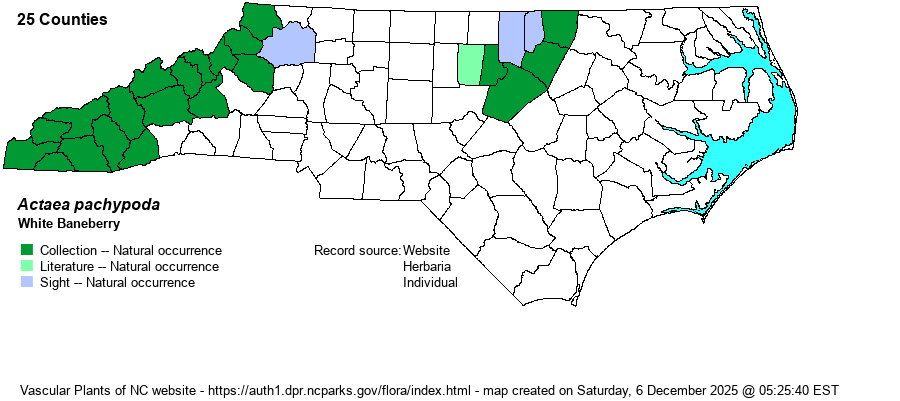| Author | Elliott | |
| Distribution | Throughout the Mountains; disjunct to the northeastern Piedmont, where there are numerous records over a 7-county region. This gap is real, not an artifact of collecting and observations.
This is a very widespread Northeastern species, ranging from eastern Canada south mainly through the Appalachians to northern GA, and surprisingly to southern MS and LA. | |
| Abundance | Fairly common to common in the Mountains. Uncommon (but not rare) in the northeastern Piedmont; dozens of localities known from the northeastern Piedmont. | |
| Habitat | This is a classic species of rich forests, and thus in the Mountains is seen most often in Rich Cove Forest natural community. In the northeastern Piedmont it occurs both in Basic Mesic Forest and Mesic Mixed Hardwood Forest communities. |
| Phenology | Blooms in April and May, and fruits from August to October. | |
| Identification | This is a moderately robust herb, growing to about 2.5-3 feet tall, with scattered branches. This species, as do many others in the family, has compound leaves. Each leaf is 2- to 3-times divided, with the largest leaflets averaging about 2-3 inches long; all leaves are strongly serrated on the margins. The several other Actaea (formerly Cimicifuga) species have quite similar leaves and you might have to see reproductive parts to be sure of the identification. (Even species such as Aruncus and Astilbe might be confused with it by some biologists.) However, when in bloom, in spring, it becomes obvious -- the racemes at the ends of the branches are short and somewhat dense, thimble-shaped, about 1-2 inches long and not quite as wide, with perhaps 15-25 white flowers (with the color mostly being the pistils and stamens and not the very slender petals). The 4-5 white sepals quickly drop off before the flowers are fully opened. Even more impressive is the fruit; the many fruits (berries) on the raceme are round and white, about 1/3-inch across, and the fruit stalk (pedicel) becomes red, such that the white ball has a red "eye" on the side opposite the base of pedicel -- the "doll's eye". Thankfully, this is a reasonably widespread wildflower in the mountains, and as it blooms in spring, it is one of the favorites of wildflower enthusiasts on strolls though cove forests at that season. | |
| Taxonomic Comments | None
| |
| Other Common Name(s) | Doll's-eyes, White Cohosh | |
| State Rank | S4 | |
| Global Rank | G5 | |
| State Status | | |
| US Status | | |
| USACE-agcp | FACU link |
| USACE-emp | UPL link |

